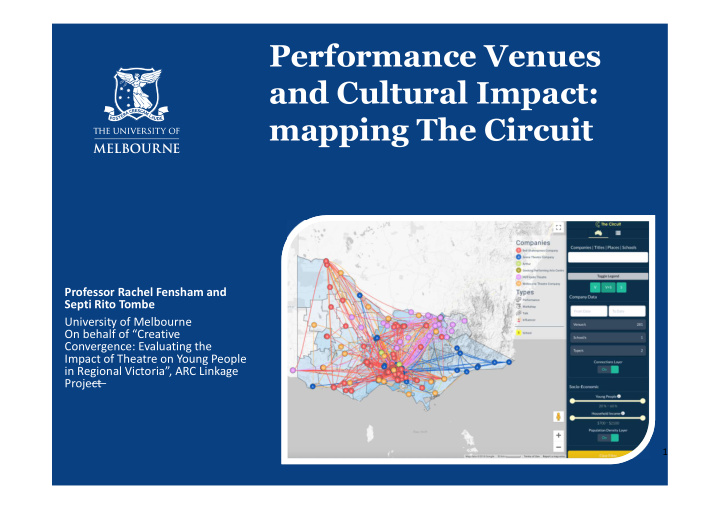



Performance Venues and Cultural Impact: mapping The Circuit Professor Rachel Fensham and Septi Rito Tombe University of Melbourne On behalf of “Creative Convergence: Evaluating the Impact of Theatre on Young People in Regional Victoria”, ARC Linkage Project 1
To evaluate the impact of regional Aims of theatre for young people in Victoria Creative By assessing the opportunities for Convergence convergence between People, Place and Media. 2
Data inputs AusStage live performance database contains We added: over 100, 000 performing arts events ABS data collected through the 2016 Census to including full metadata with contributors, provide information by local government area dates, and venues. (LGA) It is mostly reliable but not comprehensive, on population density, average household and we added items to the database from the income, youth population (under 18), and companies. ethnicity (by ancestry). We also collected additional data internal to Some of these datasets were sourced from the companies, such as audience size, schools AURIN, the Australian Urban Research participation, type of program and in some Infrastructure Network. cases, cost.
What software was applied or developed for data integration? The tool was created on HTML/JS/CSS stack We also used Datatables , a library which which is usually used for the front-end (user consists of JS/CSS that makes it easier to show interface) side of a web application. the data in table format. All standard table functions, such as sort, filter, and paging are In modern web browsers, this storage is handled by the library, however, to match our called "Local Storage” , and it stores all data need we introduced many modifications, for fetched from AusStage, ABS, and AURIN. instance to our search fields. For the map, we used Google Map APIs (Application Programming Interface), to show the map layer and standard map functions such as zoom and pan. - On top of that layer, we usdc D3.js , a library for JS to create the nodes, lines, population density layer. This library eases makes "svg" (a picture format) representation of the stored data based on our instructions. 4
Visual display Originally, adopting the Unimelb colour scheme , the map theme was changed to a lighter colour to make the nodes, lines, and density layers more prominent. The ‘I want hue’ tool from the Sciences-Po Media Lab generates the colour of the nodes and lines, with awareness of using colourblind- friendly colours to accommodate various users, although it reduces some colour contrasts. The layout is inspired by the Gutenberg Diagram , which recommends the left side of a computer screen. As our main content is the map and the table, the filters are on the right. The filter groupings and general layout of objects were mostly based on Gestalt Principles (a common practice of web design layouts) and has been subject to continuous modification. 5
Events, Venues, and Schools A later addition to the datasets was more inclusion of schools data points in order to identify their proximity to events and venues. This independent dataset has been integrated as another layer.
Regional Distributions (2012-17) L-R, T-B: Bell Shakespeare, Melbourne Theatre Company, Geelong Performing Arts Centre, Hothouse Theatre, Arena Theatre Company, Arthur
Regional Exposure and Geographic Isolation L-R: Western Victoria, East Gippsland
Schools Involvement and Access (In Development) Hothouse, MTC Melbourne, Arena Touring, Bell Education Performances and Regional Mentorship The information points do not provide representations of scale although we have discussed whether these might be added, for instance, to show an audience of 1- 50, 50-200, 200+
Thank you The CIRCUIT, will be available from the Digital Studio project page, Creative Convergence also: Professor Rachel Fensham University of Melbourne
Recommend
More recommend